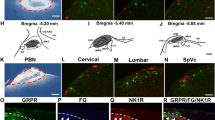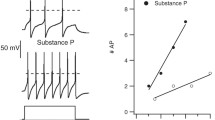Abstract
Morphine produces a multiphasic modulation of K+-evoked substance P release from trigeminal slices and dorsal root ganglion neurons in culture. We now found that the C-fiber stimulant, capsaicin (1 μM), evoked release of substance P that was inhibited, enhanced and inhibited by 0.1 nM, 1 μM, and 10 μM morphine, respectively. This morphine's multiphasic effect was blocked by naloxone (100 nM). Neonatal treatment with capsaicin produced thermal hypoalgesia and abolished the multiphasic effect of morphine on substance P release evoked by 50 mM K+. These findings suggest that the multiphasic modulation of substance P release by morphine is dependent on C-type afferents and may be of relevance to nociception.
Similar content being viewed by others
REFERENCES
Bossut, D., Frank, H., and Mayer, D. J. 1988. Is substance P a primary afferent neurotransmitter for nociceptive input? II. Spinalization does not reduce and intrathecal morphine potentiates behavioral responses to substance P, Brain Res., 455:232–239.
Yaksh, T. L. 1986. The central pharmacology of primary afferents with emphasis on the disposition and role of primary afferent substance P. Pages 165–96, in Yaksh TL, Functional organization of spinal afferent processing, Plenum Press, New York.
Jessell, T. M., and Iversen, L. L. 1977. Opiate analgesics inhibit substance P release from rat trigeminal nucleus, Nature, 268:549–551.
Chang, H. M., Berde, C. B., Holz, G. G., Steward, G. F., and Kream, R. M. 1989. Sufentanil, morphine, met-enkephalin, and κ-agonist (U-50,488H) inhibit substance P release from primary sensory neurons: a model for presynaptic spinal opioid actions, Anesthesiology, 70:672–677.
Go, V. L. W., and Yaksh, T. L. 1987. Release of substance P from cat spinal cord, J. Physiol. (Lond.), 391:141–167.
Pang, I.-H., and Vasko, M. R. 1986. Morphine and norepinephrine but not 5-hydroxytryptamine and gamma-aminobutyric acid inhibit the potassium-stimulated release of substance P from rat spinal cord slices, Brain Res., 376:268–279.
Suarez-Roca, H., Abdullah, L., Zuniga, J., Madison, S., and Maixner, W. 1992. Multiphasic effect of morphine on the release of substance P from the rat trigeminal nucleus caudalis, Brain Res., 579:187–194.
Suarez-Roca, H., and Maixner, W. 1992. Morphine produces a multiphasic effect on substance P release from trigeminal nucleus caudalis slices by activating different opioid receptor subtypes, Brain Res., 579:195–203.
Suarez-Roca, H., and Maixner, W. 1992. Delta-opioid receptor activation by [D-Pen2,D-Pen5]enkephalin and morphine inhibits substance P release from trigeminal nucleus slices, Eur. J. Pharmacol., 229:1–7.
Hokfelt, T., Kellerth, J. O., Nillson, G., and Pernow, B. 1975. Experimental immunohistochemical studies on the localization and distribution of substance P in cat primary sensory neurons, Brain Res., 100:235–252.
Nagy, J. I., Iversen, L. L., Goedert, M., Chapman, D., and Hunt, S. P. 1983. Dose-dependent effects of capsaicin on primary sensory neurons in the neonatal rat, J. Neurosci., 3:399–406.
Bevan, S., and Szolcsanyl, J. 1992. Sensory neurons-specific actions of capsaicin: mechanisms and applications, TIPS, 11:330–333.
Glass, J., Chan, W. C., and Gintzler, A. R. 1986. Direct analysis of the release of methionine-Enkephalin from guinea pig myenteric plexus: Modulation by endogenous opioids and exogenous morphine, J. Pharm. Exp. Ther., 239:742–747.
Glazer, E. J., and Basbaum, A. I. 1981. Immunohistochemical localization of Leu-enkephalin in the spinal cord of rat: Enkephalin-containing marginal neurons and pain modulation, J. Comp. Neurol., 196:377–389.
Faris, P. L., Komisaruk, B. R., Watkins, L. R., and Mayer, D. J. 1983. Evidence for the neuropeptide cholecystokinin as an antagonist of opiate analgesia, Science, 219:310–312.
Tang, J., Chou, J., Ladarola, M., Yang, H. Y., and Costa, E. 1984. Proglumide prevents and curtails acute tolerance to morphine in rats, Neuropharmacology, 23:715–718.
Neil, A. 1984. Affinities of some common opioid analgesics towards four binding sites in mouse brain, Naunyn-Schmiedeberg's Arch. Pharmacol., 238:24–29.
Besse, D., Lombard, M. C., Zajac, J. M., Roques, B. P., and Besson, J. M. 1990. Pre-and postsynaptic distribution of mu, delta and kappa receptors in the superficial layers of the cervical dorsal horn of the rat spinal cord, Brain Res., 521:15–22.
Shen, K.-F., and Crain, S. M. 1989. Dynorphin prolongs the action potential duration of mouse sensory ganglion neurons by decreasing a potassium conductance whereas the specific kappa opioid, U-50,488H does so by increasing a calcium conductance, Prog. Clin. Biol. Res., 328:343–346.
Suarez-Roca, H., and Maixner, W. 1995. Morphine produces a bidirectional modulation of substance P release from cultured dorsal root ganglion neurons, Neurosci. Lett., 194:1–4.
Kayser, V., Bessar, J. M., and Guilbaud, G. 1987. Paradoxical hyperalgesic effect of exceedingly low doses of systemic morphine in an animal model of persistent pain (Freund's adjuvant-induced arthritic rats), Brain Res., 414:155–157.
Woolf, C. J. 1981. Intrathecal high dose morphine produces hyperalgesia in the rat, Brain Res., 209:491–495.
Jancso, G., and Jancso-Gabor, A. 1980. Effect of capsaicin on morphine analgesia. Possible involvement of hypothalamic structures. Naunyn Schmiedebrgs Arch. Pharmacol., 311:285–288.
Author information
Authors and Affiliations
Rights and permissions
About this article
Cite this article
Cano, G., Arcaya, J.L., Gómez, G. et al. Multiphasic Morphine Modulation of Substance P Release from Capsaicin-Sensitive Primary Afferent Fibers. Neurochem Res 24, 1203–1207 (1999). https://doi.org/10.1023/A:1020963120333
Issue Date:
DOI: https://doi.org/10.1023/A:1020963120333




